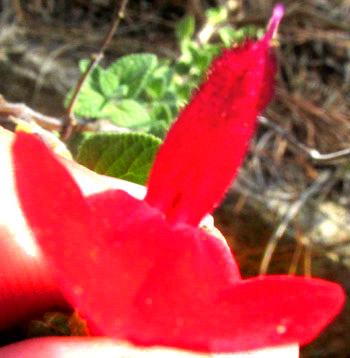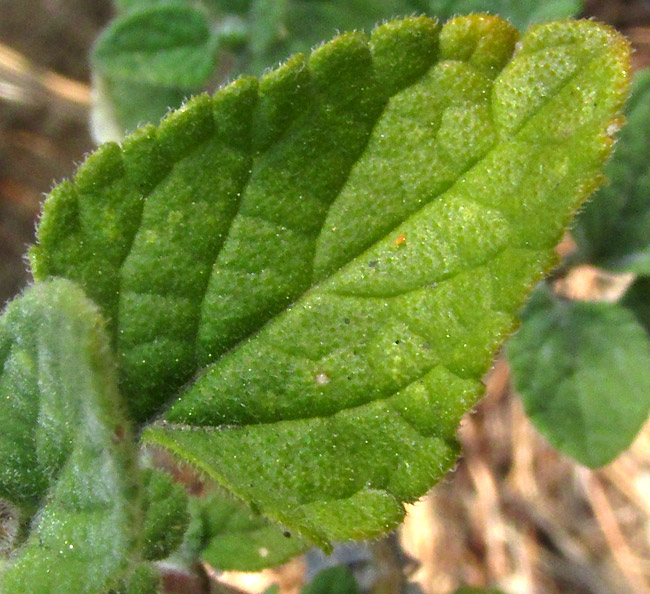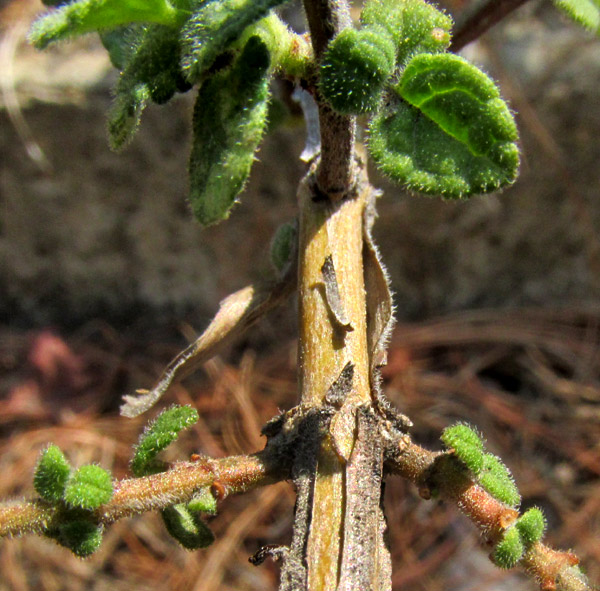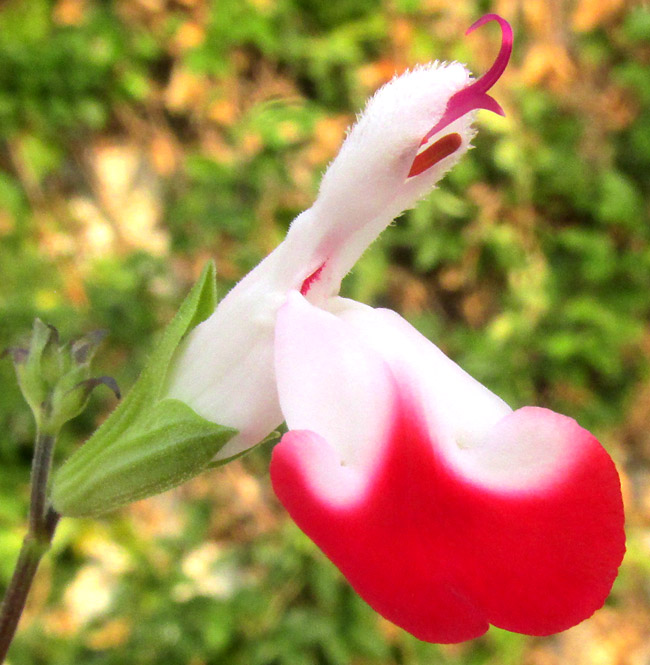Excerpts from Jim Conrad's
Naturalist Newsletter
entry from field notes dated May 5, 2023, taken along paved road to El Doctor, about 2km above the intersection with Hwy 120 running east to San Joaquín; juniper, oak and pine forest on limestone bedrock; elevation ±2500m (8200 ft); Eastern Sierra Madre mountains of east-central Querétaro state, MÉXICO, (N20.88°, W99.62°)
LITTLE-LEAF SAGE

On a steep, rocky slope along the road to El Doctor, a spindly, scraggly bush caught my eye at the highway's curb, and above you can see why. The cherry-size splash of red was spectacularly intense amid the general shadowy brownness and subdued greens. Up close, it was clear that here was that big, complex genus in the Mint Family known as sages, Salvia.


You know a Salvia when your Mint Family blossom is strongly bilaterally symmetrical (emphasized at the right, flower viewed from below), and the flower's two stamens curve upwardly, keeping snug against the ceiling formed by the top, hood-like corolla lobe. Above, the stamens are seen barely peeping from beneath the bristly-hairy hood, with a bit of yellow pollen at their anther tips. The backward-curling purple item above them is the stigma which, when mature, receives pollen from hummingbird pollinators.
Keeping in mind that Salvia identification can be difficult, it was important to look at other plant details. Here's what last year's dried-out calyxes looked like:

And the plant's small, newly emerged leaves:

The stems were woody, with exfoliating old bark:

Estimates of the number of species in the genus Salvia range from anywhere between 700 to nearly 3000. Currently the GBIF database recognizes 1344 worldwide species. There's no comprehensive study of the taxonomy of the genus for North America, Europe or Mexico, though the Flora of China makes an effort, documenting 84 species there, but cautioning of "...many taxonomic problems in the flora area." In our neighboring Mexican state of Hidalgo, the 2022 work by José Luis Villaseñor and others entitled "Riqueza y distribución de la flora vascular del estado de Hidalgo, México" lists 54 Salvia species for that state, but no effort is made to sort them out. Few if any species here in Querétaro won't appear on the Hidalgo list, so for us the question becomes, which of the 54 species listed for Hidalgo is our roadside Salvia?
Comparing our roadside species with Internet images of all 54 species is greatly simplified by the fact that in our area the vast majority of species are blue flowered. Of the relatively few red-flowered ones, by far the flowers of most species bear long, slender hoods, with less dominant lower lobes, while our blossom does the opposite. In such a way, our plant reveals itself as the relatively commonly occurring SALVIA MICROPHYLLA.
This is a world-famous species because I'm not the only one impressed with the little blossoms' explosively intense redness. Wikipedia's Salvia microphylla page currently lists and describes 30 named cultivars and hybrids, ranging from 'Alba' with white flowers, to 'Wild Watermelon' with large, pink flowers with dark calyxes. In a friend's backyard, the very popular cultivar sold under the name of 'Hot Lips' is grown, its flower shown below:

Note that despite the great difference in color, the size, structure and relative proportions of blossom parts are identical to our wild form.
All the cultivars of this species are loosely referred to as "Mexican salvias," but what does an English speaker call our wild species, which is native from Arizona in the US to southern Mexico? Among website producers several names are used. One of the most common is Baby Sage. Blackcurrant Sage sometimes is used, or local names like Red Canyon Sage, or habitat-reflecting ones like Mountain Sage. Some resolve the mess of names by translating the Latin, microphylla clearly enough suggesting the name Little-leaf Sage.
Like the wild form, even the 'Hot Lips' cultivar's leaves when crushed produce a minty odor. This species, like all mints with minty-smelling leaves, traditionally has been used to make teas, and for various medicinal purposes, including spiritual ones. If a shaman cleanses and fortifies your spirit against dark forces, he or she may briskly brush your body with a bouquet of various herbs, sometimes including Salvia species, which leaves the whole area around the patient smelling clean and minty.